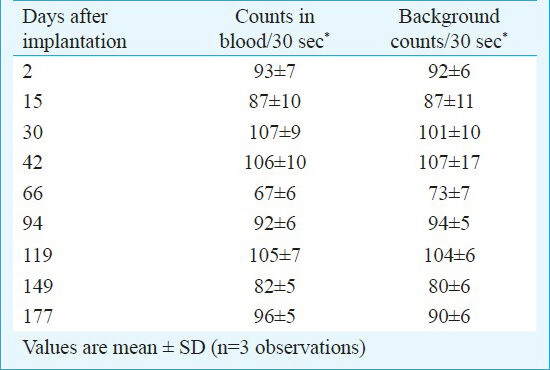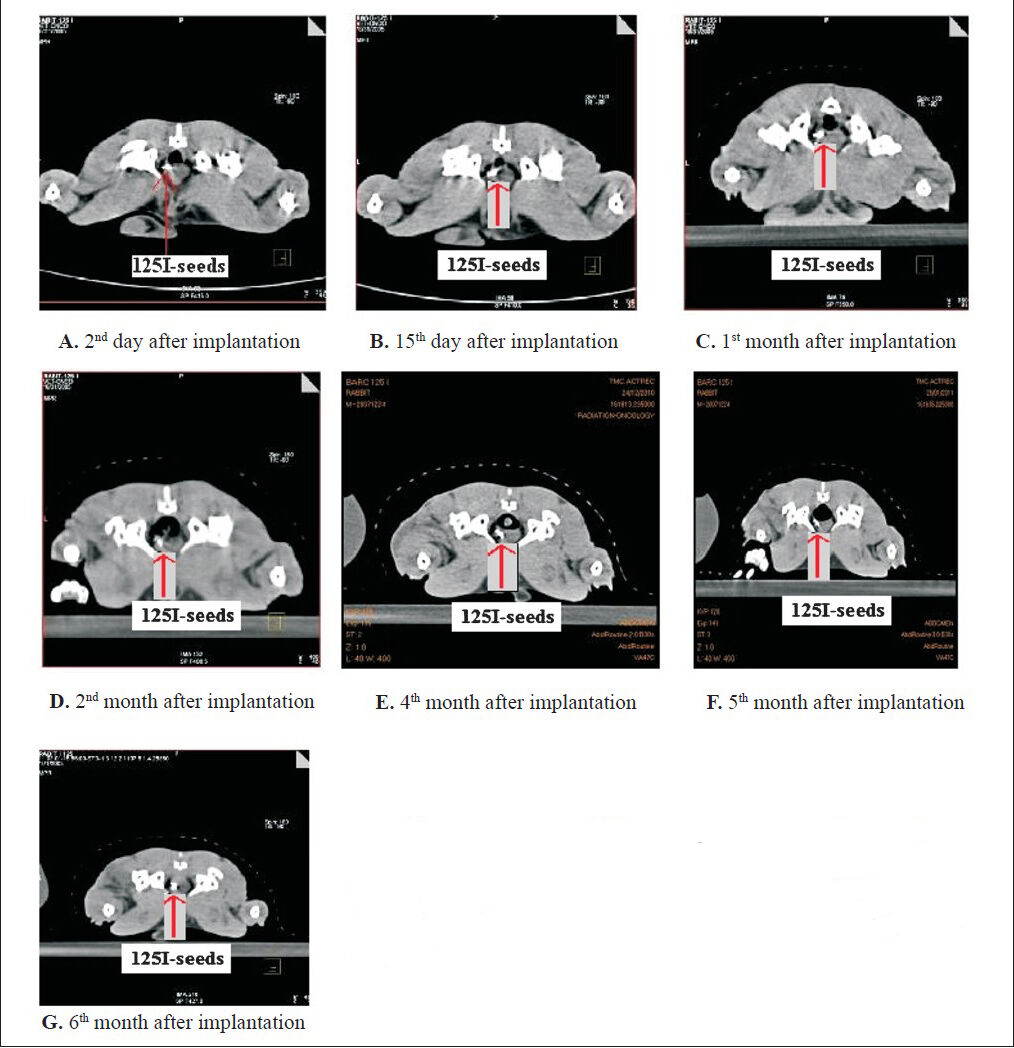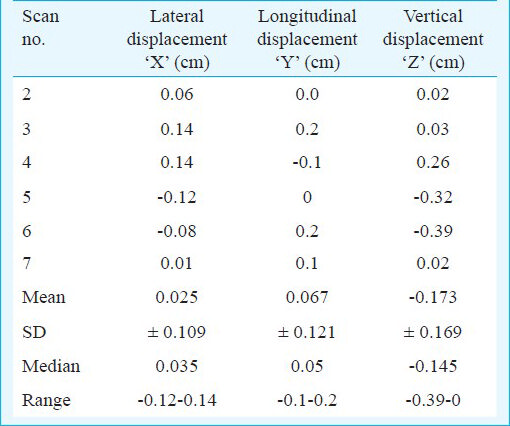Translate this page into:
Bioevaluation of 125I Ocu-Prosta seeds for application in prostate cancer brachytherapy
Reprint requests: Dr Grace Samuel, Head, Radiopharmaceuticals Evaluation Section, Radiopharmaceuticals Division Bhabha Atomic Research Centre, Mumbai 400 085, India e-mail: grace@barc.gov.in
-
Received: ,
This is an open-access article distributed under the terms of the Creative Commons Attribution-Noncommercial-Share Alike 3.0 Unported, which permits unrestricted use, distribution, and reproduction in any medium, provided the original work is properly cited.
This article was originally published by Medknow Publications & Media Pvt Ltd and was migrated to Scientific Scholar after the change of Publisher.
Abstract
Background & objectives:
In recent years, brachytherapy involving permanent radioactive seed implantation has emerged as an effective modality for the management of cancer of prostate. 125I-Ocu-Prosta seeds were indigenously developed and studies were carried out to assess the safety of the indigenously developed 125I-Ocu-Prosta seeds for treatment of prostate cancer.
Methods:
Animal experiments were performed to assess the likelihood of in vivo release of 125I from radioactive seeds and migration of seeds implanted in the prostate gland of the rabbit. In vivo release of 125I activity was monitored by serial blood sampling from the auricular vein and subsequent measurement of 125I activity. Serial computed tomography (CT) scans were done at regular intervals till 6 months post implant to assess the physical migration of the seeds.
Results:
The laser welded seeds maintained their hermeticity and prevented the in vivo release of 125I activity into the blood as no radioactivity was detected during follow up blood measurements. Our study showed that the miniature 125I seeds were clearly resolved in CT images. Seeds remained within the prostate gland during the entire study period. Moreover, the seed displacement was minimal even within the prostate gland.
Interpretation & conclusions:
Our findings have demonstrated that indigenously developed 125I-Ocu-Prosta seeds may be suitable for application in treatment of prostate cancer.
Keywords
125I seeds
permanent implant brachytherapy
prostate cancer
Prostate cancer is the most prevalent form of malignancy in the male population in the West. Transperineal interstitial permanent prostate brachytherapy has emerged as a promising and viable treatment option for patients with clinically localized and early stage prostate cancers. It is a simple outpatient procedure with low morbidity and high dose conformity. There are several reports in literature suggesting that the biochemical disease control obtained by brachytherapy with 125I seeds is similar to radical prostatectomy and external beam radiation therapy (EBRT)4. This modality of treatment allows delivery of a highly localized radiation dose that is not achievable by conventional external beam radiation therapy. Interstitial brachytherapy for prostate cancer is convenient, cost-effective, and offers minimal morbidity in appropriately selected patients and does not compromise the patient's quality of life. Candidates with low risk prostate cancer [pre-treatment prostate specific antigen (PSA) < 10 ng/ml, Gleason score (GS) < 7, prostate volume, < 60 ml and stage T1-T2a] are considered ideal for interstitial brachytherapy5. The three radioactive isotopes currently used for making radioactive seeds are 125I (Iodine-125), 103Pd (Palladium-103) and 137Cs (caesium-137). In order to cater to the need of ageing population and to tap the therapeutic potential of permanent radioactive seed implantation, 125I Ocu-Prosta seeds were developed as per the reported procedure678. During therapy, the radioactive seeds come in direct contact with the body fluids and in case of leakage of activity from the seeds, deposition of activity into the thyroid gland and other non target tissues is observed9. Hence, bioevaluation of the seeds was found essential to ensure integrity of seeds and safety during therapy. The verification of the seed migration after implantation is also vital to ensure desired post-implant dosimetry. Following implantation, these 125I seeds will remain in prostate tissue permanently, the probability of dispersion of radioactivity from the radioactive seed as well as its physical migration is a concern which needs to be addressed. Therefore, in the present study, a thorough biosafety evaluation of the indigenously prepared seeds implanted in the prostate gland of a healthy rabbit was undertaken at Radiopharmaceuticals division, BARC, Mumbai during 2010-2011.
Material & Methods
Silver wires of 0.5 mm (ϕ) with guaranteed purity were purchased from Silver Plaza, Mumbai. Titanium capsules of 0.8 mm (OD) x 4.75 mm (l) were fabricated by Titan Industries Limited, India. 125I as Na125I for seed preparation was procured from Bhabha Atomic Research Centre, India. A 50W Nd: YAG laser welding system M/s Quanta Systems, Italy, was used for welding the sources. Well type ion chamber (Sun Nuclear Corporation, Melbourne, FL, USA) calibrated for standard 125I source of similar dimension was used for radioactive measurement. MICK applicator was obtained from M/s Mick Radio-Nuclear Instruments, Mount Vernon, NY, USA. Computed tomography (CT) scans were carried out using Siemens, SOMATOM, sensation version 4 machine™, USA.
Preparation of 125I seeds: The source core consisted of a palladium coated silver wire [3 mm (l) × 0.5mm (ϕ)] in which 125I was incorporated as per the reported procedure78. These source cores were encapsulated in titanium capsules of 4.75 mm (l) × 0.8 mm (OD) using a 50 W, Nd:YAG laser welding system. The 125I seed is a radioactive sealed source, in which the source core is positioned inside the titanium capsule, welded at one extremity. The source strength of 125I seed for prostate implants is usually between 11.1-29.6 MBq per seed. Each 125I seed was subjected to checks such as visual inspection, activity measurement, leak test, immersion test, swipe test, etc. according to the standard procedure7.
Bioevaluation studies: The animal study was carried out in accordance with the institutional animal ethics committee of BARC, Mumbai. The bioevaluation studies were carried out in a healthy male New Zealand rabbit as an experimental model. The study involved surgical intervention followed by repeated exposure to X rays. Due to relatively small size of rabbit prostate, two radioactive seeds containing 13.7MBq 125I per seed were implanted in prostate gland of the rabbit (weight 2.5 kg) by surgical intervention.
In vivo release of 125I activity was studied by withdrawing blood from the animal and measurement of 125I activity in the blood in a NaI (Tl) gamma scintillation counter from ECIL, India. Marginal auricular vein was used for serial blood sampling because of the ease of repeated sampling. Sampling was started after post-operative recovery of the animal on 2nd day after implantation.
The migration of the seeds from the implanted site to other tissues was monitored by serial CT scans at periodic intervals for six months study period. A thermoplastic mould (Orfit™) was used to immobilize the animal and maintain reproducibility during serial CT scans. Radio opaque fiducial markers were placed on the orfit using laser guidance. These markers were later used to precisely calculate the distance of the seeds; however, variability of the position of the fiducial markers was observed due to the breathing movements which lead to erroneous results while measuring the seed distance, later a fixed bony landmark (tip of the pubic arch) was used to measure the seed distance. The migration (displacement) of the seeds from original site of implantation in the serial scans was calculated with respect to the baseline scan (e.g., if lateral distance from tip of pubic arch is x cm in the baseline scan and in subsequent scan it is x2 cm, then the lateral displacement is considered to be x-x2 cm). The vertical and anterior-posterior (A-P) displacements were also calculated in a similar way. The seed displacement was considered to be negative if it was less than the baseline scan and was considered positive if it was greater than the baseline scan.
The rabbit was administered with anaesthetics (Ketamine 50 mg/kg and Xylaxine 10 mg/kg) before the scan. A whole body CT scan of 2.5 mm slice thickness was performed and was later reconstructed into 1 mm slice thickness. After 6 months, seeds were recovered from prostate gland of rabbit and activity estimated. The seeds were examined for their integrity as well as structural appearance.
Results
Quality control of seeds: 125I seeds were prepared and subjected to strict quality control assessment as per the guidelines10. Results of surface contamination test and leak test conducted on the seeds revealed that the radioactivity levels were well below 185 Bq. The uniformity in the distribution of 125I activity in the seed was examined by autoradiography.
Two 125I Ocu-Prosta seeds were implanted in the prostate gland of the rabbit. The animal was monitored for any intraoperative or post surgical complications and was given prophylactic antibiotics. In the post-operative period, the rabbit had mild to moderate loose motion for two days, which could be attributed to the effect of anaesthesia and antibiotics administered after surgery. However, the loose motions resolved spontaneously without any intervention.
In vivo studies: Blood (1 ml) was drawn from the marginal auricular vein of the rabbit ear on 2nd and 15th day after implantation and subsequently at monthly intervals up to a period of six months. The results are summarized in Table I.

It was seen from the result that the measured activity was close to background counts. The blood tests did not detect any radioactivity during the follow up period, which indicated that the laser welded seeds maintained their hermeticity and prevented the in vivo release of 125I into the blood.
Seed migration: Initially, ultrasononography of 125I Ocu-Prosta seeds was carried out to visualize the seeds after implantation in the prostate phantom. However, due to nonavailability of ultrasound probe for rabbit, tracking of seeds was carried out by CT imaging. Single photon emission computed tomography (SPECT) of 125I seeds after permanent brachytherapy for prostate cancer has also been reported11. However, due to unavailability of appropriate scintigraphy machine for rabbit imaging at our institute, we conducted the seed migration study using CT scan. Moreover, with CT imaging the seed position can be related with known anatomical and soft tissue land marks.
Both the seeds were observed in the prostate gland during the entire period of the study (6 months). Serial CT images are shown in the Figure (A-G). The exact position of the seeds was calculated from an anatomical bony landmark (tip of pubic arch). Table II shows the distance/position of seeds from the bone (tip of pubic arch). Tables II and III give the distance of the seeds from the pubic arch and their displacements in all the three dimensions with respect to baseline CT scan. Our observations showed that the maximum distance of the seeds was in the anterior-posterior (A-P) direction or Z-dimension with a mean of 1.17 cm (range: 0.93-1.32 cm; SD ± 0.168) and minimum in superior-posterior direction (Y-dimension) with a mean distance of 0.15 cm from the pubic arch (range: 0 - 0.3; SD ± 0.11). The mean lateral displacement (X), mean vertical displacement (Z), and the mean longitudinal displacement (Y) were only 0.025, -0.173 and 0.067 cm, respectively (Table III).

- Serial CT images of the rabbit showing the implanted with seeds together maintaining their position within the prostate gland. (A) 2nd day after implantation. (B) 15th day after implantation. (C) 1st month after implantation. (D) 2nd month after implantation. (E) 4th month after implantation. (F) 5th month after implantation. (G) 6th month after implantation.


Physical integrity of the encapsulated seed: The seeds after recovery were examined visually for integrity and were found to be intact with no visual damage. The seeds were subjected to leakage test in which the recovered 125I seeds were placed in boiling water for about 2 min. Non-appearance of bubbles from the sealed sources indicated retention of hermetic characteristics. Further, these were subjected to swipe test by swiping the sources using alcohol immersed cotton wool and checking the radioactive content in a NaI(Tl) scintillation counter. Radioactivity in the immersed cotton wool was less than 185 Bq (5nCi) which indicated secured encapsulation. The radioactivity associated with seed was estimated to be ~444KBq (12 µCi) after 10 months that accounted for the decay loss and no release of activity.
Discussion
Safety and quality of the encapsulated 125I seed is the prime consideration for the therapeutic use. The safety features of radioactive sources depends on the radioisotope used, process of making source core, capsule material used, capsule design and encapsulation technique.
The three commonly used isotopes used in permanent radioactive seed implantation are 125I, 103Pd and 137Cs. 125I has a half-life of 60 days with an average energy of 28 KeV, 103Pd has a half-life of 17 days with an average energy of 21 KeV and 137Cs has a half-life of 9.7 days with energy of 29 KeV. The photon energies of these isotopes are nearly identical as the penetration distance in the human tissue for these radioisotopes is only 1.7 cm, which allows for localizing the energy inside the tumour instead of irradiating the surrounding organs. The primary difference between these is the rate at which these decay1213141516. Although there appears to be no significant difference in the choice of one radionuclide over another, the lack of large scale production process for 103Pd and 137Cs limits their application. Moreover, the logistics and cost considerations of these isotopes do not permit their wide use. On the other hand, 125I with its relatively longer half-life coupled with well-established production of 125I in several GBq quantities in the research reactor is a cost effective isotope. Prior to the deployment of 125I seeds for clinical prostate brachytherapy, it is important to study the migration probability (within and outside the prostate) as well as in vivo release of 125I activity from the seed.
Radioactive seeds should be placed within the treatment volume in a predetermined array and held in that array throughout the therapeutic life of the sources, for propitious therapeutic outcome. In prostate brachytherapy, seeds can detach from their deposited sites and move locally in the pelvis or migrate to distant sites including the pulmonary and cardiac regions. The prostatic capsule has a rich venous plexus with vessels large enough to accommodate seeds. Seeds placed extraprostatically have access to this plexus and often migrate away from their intended position via venous circulation. Through the venous pathway, seeds can migrate through the inferior vena cava and into the other part of the body1718. For therapeutic efficacy, the seed should ideally remain within the prostate. Undesirable consequences of seed migration include inadequate dose coverage and dosimetry within the tumour and the possible morbidity due to tissue irradiation effects at the site of migration.
In our animal study, 125I Ocu-Prosta seeds were easily tracked by CT imaging during follow up of the rabbit implanted with seeds in the prostate. Physical migration of the seed was minimal and was within the prostate gland. None of the seeds implanted migrated to any distant organ such as the lung or the heart although there are some reports in humans where seed migration has been noted at distant sites especially in lungs where the reported incidence of seed migration is between 0.7-55 per cent of patients19. The laser welded seeds maintained their hermeticity and prevented the in vivo release of 125I activity into the blood.
In conclusion, successful preclinical evaluation of indigenously developed 125I Ocu-Prosta seeds was done and seeds were found to be suitable for clinical application. The potential to translate these findings from rabbit to human prostate is promising.
References
- Current status and perspectives of brachytherapy for prostate cancer. Int J Clin Oncol. 2009;14:31-6.
- [Google Scholar]
- Iodine seed prostate brachytherapy: an alternative first-line choice for early prostate cancer. Prostate Cancer Dis. 2004;7:201-7.
- [Google Scholar]
- Predictors in the outcome of 125I brachytherapy as monotherapy for prostate cancer. Expert Rev Anticancer Ther. 2011;11:115-23.
- [Google Scholar]
- Permanent prostate seed brachytherapy: a current perspective on the evolution of the technique andits application. Nat Clin Pract Urol. 2007;4:658-70.
- [Google Scholar]
- A novel approach for the adsorption of 125I on silver wire as matrix for brachytherapy source for the treatment of eye and prostate cancer. Appl Radiat Isot. 2002;57:359-67.
- [Google Scholar]
- Studies on the production and quality assurance of miniature 125I radioactive sources suitable for treatment of ocular and prostate cancers. Appl Radiat Isot. 2006;64:441-7.
- [Google Scholar]
- Development of a new design 125I-brachytherapy seed for its application in the treatment of eye and prostate cancer. Appl Radiat Isot. 2009;67:1421-5.
- [Google Scholar]
- Thyroid uptake of iodine-125 after prostate permanent brachytherapy. J Urol. 2004;172:1827-9.
- [Google Scholar]
- AERB Safety Standard No. AERB / SS3 (Rev 1). Testing and classification of sealed radioactive sources. Mumbai: Atomic Energy Regulatory Board, Government of India; 2001.
- [Google Scholar]
- Scintigraphic detection of 125 I seeds after permanent brachytherapy for prostate cancer. J Nucl Med. 2008;49:541-5.
- [Google Scholar]
- 125I versus 103Pd for low-risk prostate cancer: preliminary PSA outcomes from a prospective randomized multicenter trial. Int J Radiat Oncol Biol Phys. 2003;57:1297-303.
- [Google Scholar]
- Correlation of medical dosimetry quality indicators to the local tumor control in patients with prostate cancer treated with iodine-125 interstitial implants. Med Phys. 1998;25:2293-307.
- [Google Scholar]
- Postimplant dosimetry for 125I prostate implants: definitions and factors affecting outcome. Int J Radiat Oncol Biol Phys. 2000;48:899-906.
- [Google Scholar]
- A nomograph for permanent implants of palladium-103 seeds. Int J Radiat Oncol Biol Phys. 1993;27:129-35.
- [Google Scholar]
- I-125 versus Pd-103 for low-risk prostate cancer: morbidity outcomes from a prospective randomized multicenter trial. Cancer J. 2002;8:67-73.
- [Google Scholar]
- American Brachytherapy Society (ABS) recommendations for transperineal permanent brachytherapy of prostate cancer. Int J Radiat Oncol Biol Phys. 1999;44:789-99.
- [Google Scholar]
- Radioactive seed migration to the chest after transperineal interstitial prostate brachytherapy: extraprostatic seed placement correlates with migration. Int J Radiat Oncol Biol Phys. 2004;59:419-25.
- [Google Scholar]
- Migration of prostate brachytherapy seeds to the vertebral venous plexus. Brachytherapy. 2006;5:127-30.
- [Google Scholar]






